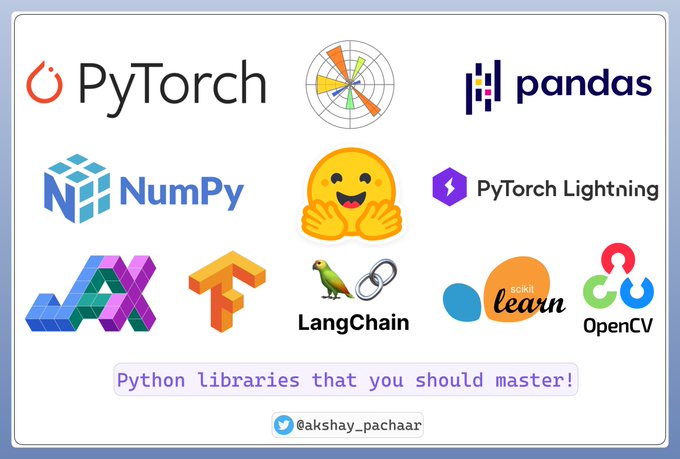With the advent of data science in 2016, my journey has been a continuous exploration of tools that power the machine learning landscape. In this guide, we delve into crucial Python libraries, providing not only links to official documentation but also curated video tutorials for a holistic learning experience.
1️⃣ NumPy
NumPy, the cornerstone of scientific computing in Python, may seem deceptively simple at first. However, mastering its array operations and mathematical functions is fundamental. The official NumPy documentation is an invaluable resource, offering comprehensive insights. Additionally, a video tutorial is provided for practical guidance.
2️⃣ Pandas
Pandas emerges as the go-to library for data manipulation and analysis. The official Pandas documentation serves as a robust guide, covering tutorials for various functionalities. Complementing this, a Pandas tutorial playlist offers hands-on learning.
3️⃣ Scikit-Learn
Scikit-Learn stands as a comprehensive Python library for machine learning, providing tools and algorithms for a myriad of tasks. The official Scikit-Learn documentation is an extensive reference. To enhance understanding, a tutorial playlist is curated.
4️⃣ PyTorch
PyTorch, the beloved deep learning framework, is a must-have in any data scientist's arsenal. Dive into the intricacies with the official PyTorch tutorials and a corresponding video tutorial playlist.
5️⃣ TensorFlow
TensorFlow, another deep learning giant, shares the spotlight. While you can choose between PyTorch and TensorFlow, proficiency in both is encouraged. The TensorFlow documentation is the ultimate guide.
6️⃣ PyTorch Geometric
For those fascinated by machine learning on graphs, PyTorch Geometric is a gem. Delve into geometric deep learning and graph neural nets with the official PyTorch Geometric documentation and a video tutorial by Stanford.
7️⃣ Matplotlib
Matplotlib shines as the go-to tool for data visualization. The official Matplotlib documentation is an extensive resource, complemented by a video tutorial playlist.
8️⃣ OpenCV
If you're venturing into computer vision, OpenCV is indispensable. Learn the ropes through the official OpenCV documentation and a video tutorial.
9️⃣ HuggingFace 🤗
HuggingFace is a treasure trove, offering a multitude of models and datasets. Explore its offerings via the official HuggingFace documentation and a video tutorial playlist.
🔟 JAX
JAX distinguishes itself with unique capabilities for high-performance machine learning. Delve into its intricacies with the official JAX documentation and a video tutorial playlist.
1️⃣1️⃣ LangChain
LangChain steps in as a framework tailored for working with LLMs. Understand its applications and features using the official LangChain documentation and avail of a free course.
1️⃣2️⃣ PyTorch Lightning ⚡️
PyTorch Lightning, crafted by @LightningAI, offers a structured and scalable PyTorch wrapper. Navigate its capabilities with the official PyTorch Lightning documentation.
1️⃣3️⃣ Bonus: @LightningAI Studios
Explore LightningAI Studios, a state-of-the-art AI Developer platform. Gain access to VSCode, FREE GPUs, Jupyter Notebook, Streamlit, and Gradio. Launch your free Studio here.
Conclusion
As we wrap up this guide, remember that mastering these Python libraries is not a destination but a continuous journey. Each library is a powerful tool in its own right, and proficiency in their application is key to unlocking the full potential of machine learning. So, embark on this learning adventure, explore, experiment, and let these libraries be the building blocks of your data science endeavors.

Comments
Post a Comment